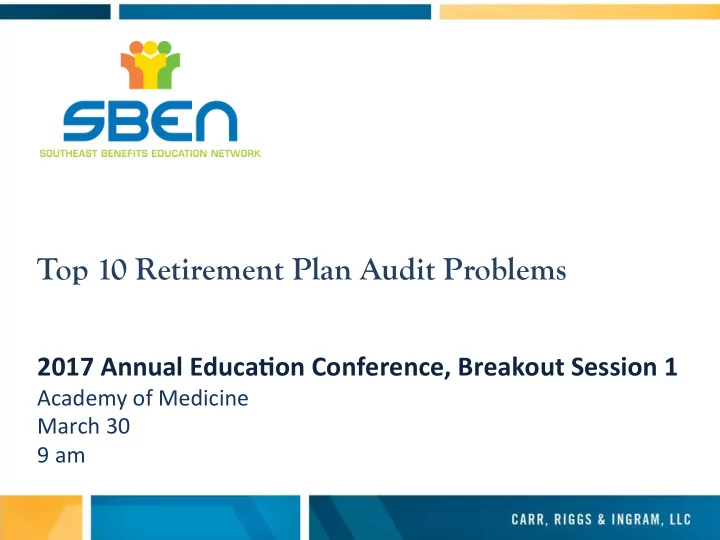

SEBC Spring Annual Educa1on 2014 Conference Top 10 Retirement Plan Audit Problems 2017 Annual Educa1on Conference, Breakout Session 1 Academy of Medicine March 30 9 am
Introduc1ons Barry Klein Hillary Collier Plan Audit Partner Plan Audit Manager Carr, Riggs & Ingram, LLP Carr, Riggs & Ingram, LLP Atlanta, GA Atlanta, GA
PROBLEM #1 The plan doesn’t follow the definition of compensation prescribed in the plan documents. What can you do? • Understand the plan definiCon of compensa)on – Is it W-2 wages? – Is it all compensaCon? – Does it include bonuses, commissions, allowances, and fringe benefits? • Note different definiCons for match vs. profit sharing contribuCons • Manual checks
PROBLEM #2 Allowing forfeitures to accumulate in the plan. What can you do? • Understand how the plan document deals with forfeitures • Make sure forfeitures do not accumulate and are used by the end of the plan year in which they occur (this is especially important if forfeitures are to be reallocated to par7cipants) • New rules for forfeiture– why this is wonderful
PROBLEM #3 The plan document and summary plan description differ. What can you do? Know and understand • your plan document Make sure your plan document • and summary plan descripCon agree. Have a copy of your plan • document readily available
PROBLEM #4 Participant loans don’t follow the requirements of the plan document or the internal revenue code. What can you do? • Don’t let parCcipant loans amorCze over too many years 5 years typical max repayment period • Fully document loans for purchase of a principal residence • Ensure reasonable interest rates are uClized on parCcipant loans • Ensure loan repayments start on Cme • Have procedures in place if employees take a leave of absence a leave of absence
PROBLEM #5 Plan sponsors don’t understand the meaning or implications of fiduciary responsibility (belief that hiring a service provider completes duty) . What can you do? • Establish a 401(k) commi^ee • Have an investment policy statement • Hold regular investment commi^ee meeCngs where you review operaCons and investments • Oversee service providers • Conduct fiduciary training
PROBLEM #6 Eligible employees have been excluded from participating in the plan. What can you do? • Look at manual enrollment issues • Look at auto enrollment issues • Understand eligibility requirements
PROBLEM #7 The plan fails nondiscrimination testing. What can you do? • Make correcCons immediately! • Watch your Cming • Review excise taxes • Consider ways to avoid a failure
PROBLEM #8 Employee deferral contributions withheld from payroll haven’t been remiBed to the plan in a timely manner. What can you do? • Understand the DOL and IRS rules and regulaCons • Observe the safe harbor rule for small plans • Understand precedent implicaCons • Be careful where there are mulCple vendors
PROBLEM #9 Hardship withdrawals were not administered properly. What can you do? • Ensure that employee contribuCons cease for 6 months following a withdrawal • Understand the plan document’s hardship provisions • Understand the documentaCon required • Verify reason for hardship– does it qualify under SH provisions? • Brief discussion of new rules for hardships
PROBLEM #10 Employer contributions aren’t made to all appropriate employees. What can you do? • Look at eligibility requirements – Employment status – Service – Age • Consider auto enroll issues • Review per payroll versus annual calculaCons
QuesCons?
Recommend
More recommend